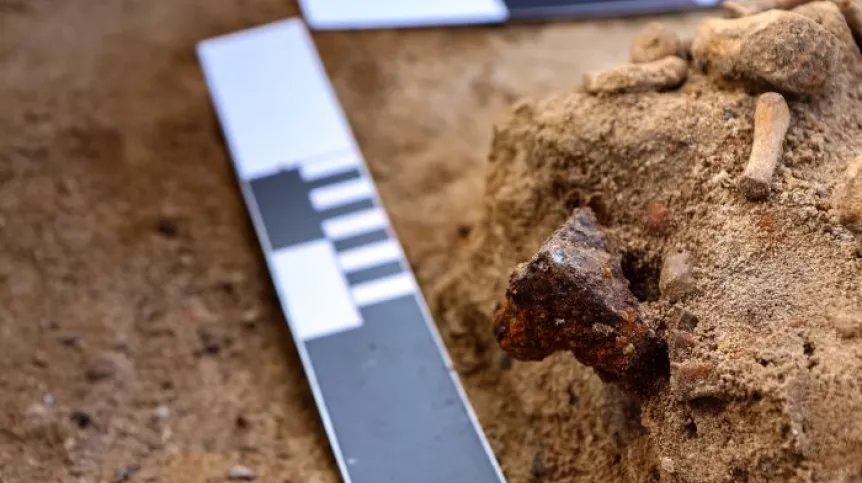
Scientists working in Pień (Kuyavian-Pomeranian Voivodeship) discovered the remains of a child buried face down, with an 'anti-vampire' triangular padlock under its foot.
According to Dr. Dariusz Poliński, the child had been buried in a cemetery of the rejected, who were feared even after death.
The seventeenth-century burial is located about 1.5 meters from the grave of the 'vampire from Pień' discovered last year - a woman buried with a sickle around her neck and a padlock closed on her toe (more - here).
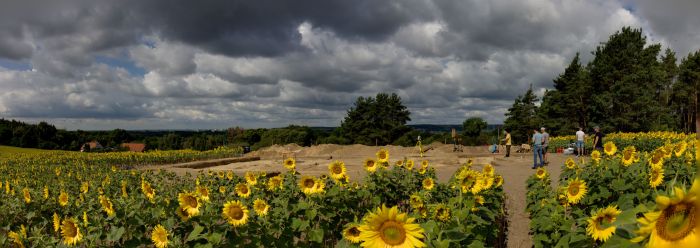
SYMBOLIC DUST BINTING RITUAL
This year, archaeologists from the Institute of Archaeology of the Nicolaus Copernicus University in Toruń continued rescue excavations, preventing the destruction of the cemetery.
On the first day, a triangular padlock was found in the topsoil, humus. In the following days, researchers were surprised by a macabre discovery - the grave of a child around 5-7 years, originally buried face down. According to the rituals of the time, such a burial was supposed to ensure that the child 'bites the dust' and does not harm the living.
After some time, the grave was unearthed and most of the child's remains excavated. Only the bones of the lower leg remain, and a padlock under the heel (and therefore probably on the toe).
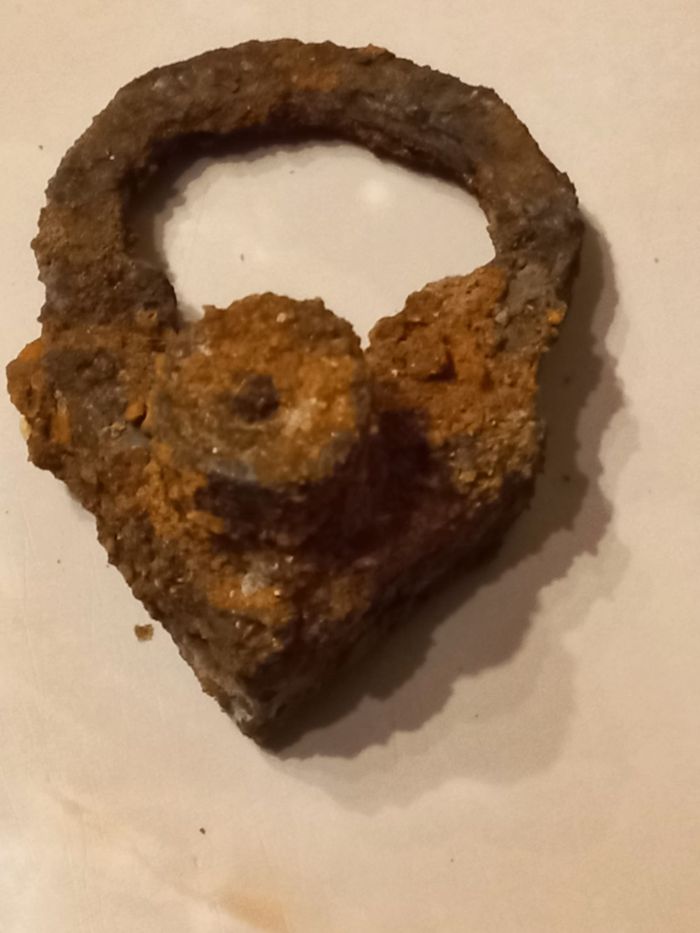
'The padlock under the foot symbolizes the closure of a stage of life and is supposed to protect against the return of the deceased, which was probably feared. Such practices originated from folk beliefs and are sometimes referred to as anti-vampire, which is not entirely accurate, because the concept of vampires appeared historically later than we date burials in Pień,’ says research director Dr. Dariusz Polinski from the Nicolaus Copernicus University.
DISEASE OF THE DEAD - A SOURCE OF FEAR FOR THE LIVING?
Near the child's grave, scientists located a pit containing the remains of three children. They found a fragment of the jaw stained green in a similar way as in the 'vampire' woman with a sickle and a padlock. However, in this case, a copper coin may have left the stain. Tests of the elemental composition on the palate of the 'vampire' showed trace amounts of gold, potassium permanganate and copper.
Dr. Czyżewski, who is working on solving this mystery, believes that the young woman was treated for the disease with a colouring potion. Was the child also feared due to the disease? These and other questions will be answered by researchers after a series of analyses.
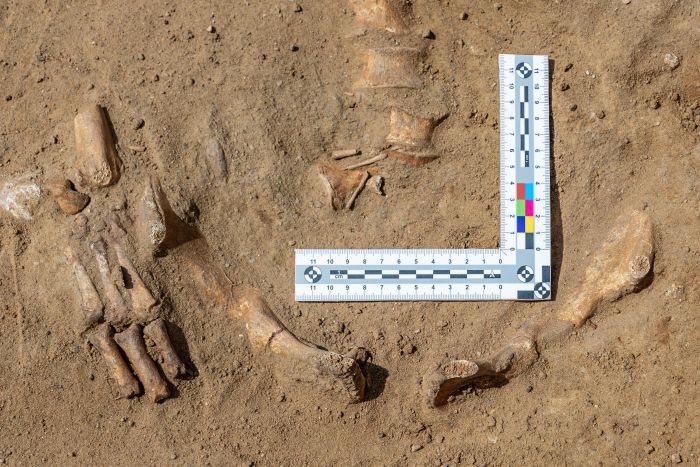
'Stereotypes of treating people suspected of vampirism testify to the fear of people who were not necessarily bad, but deviated from the norm. It could be anything: appearance, behaviour, way of speaking, as well as an illness. Genetic tests of the +vampire+ show that she was sick and maybe that was why she was perceived as being in contact with the forces of evil. There were attempts to treat her, maybe she behaved in an irrational manner, had fits or convulsions. Whether it is the same child who was buried face down, and whether there was a relationship between the people whose remains we found - we still have to determine those things,’ says Dr. Poliński.
THE CEMETERY OF OUTCASTS IN LIFE AND AFTER DEATH
In addition to the child's grave, in the northern part of the unusual cemetery, the researchers discovered other burials which they describe as strange.
'The dense structure with a large amount of stones, some of them quite large, was not suitable for digging graves, and despite that an effort was made to dig a pit and bury a 24-week-old pregnant woman. Foetal remains have been preserved, which is rare because foetal bones are fragile Why was this young pregnant woman buried in this place, and why was there a large number of stones in the backfill of the grave pit? What's more, another pit was dug next to it, in which (surprisingly) there were no remains,’ says Dr. Poliński.
The fact that at least some stones did not get into the burial pits in the examined cemetery by accident may be evidenced by their location, for example centrally on the neck or on the sternum, or by the skull. Fragments of ceramic vessels near the faces of two people buried in nearby graves are also a mystery. In addition, the lower part of the vessel was placed on the foot of the deceased buried in another grave. According to the researchers, it must have been intentional.
For the research leader, all these unusual finds are the basis to conclude that it was a cemetery for people rejected by society, in both life and death.
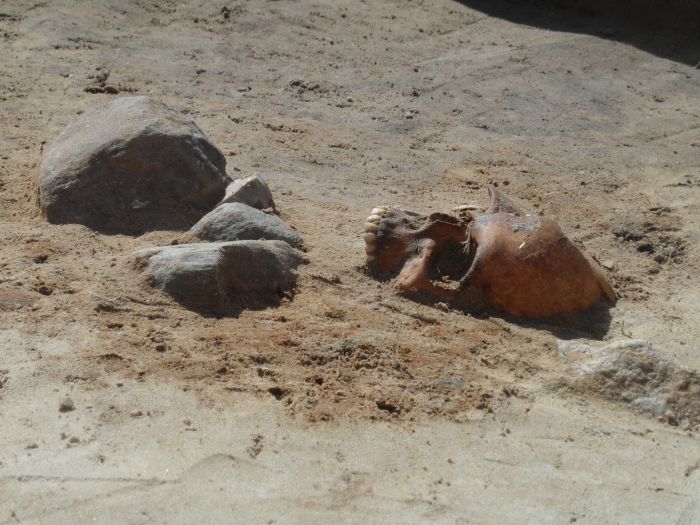
'In the near future, stable isotope tests will be carried out at the University of New Mexico on the samples from the skeletons of people buried in the cemetery in Pień. DNA tests are also planned. These analyses certainly can help determine who was buried in cemetery, why these people were treated this way, whether they were immigrants and whether they were ill,’ the archaeologist says.
He explains that even in the 17th century, the dead were supposed to be buried at the church cemetery. If that was not possible, they were sometimes buried in other places - not always legally. In Pień, however, there are no documents that could prove that burials outside the church grounds were approved - therefore it can be presumed that it was a cemetery for outcasts, where the locals buried people they did not want to remember or feared even after death .
SURPRISING AND UNIQUE ARCHAEOLOGICAL SITE
Dr. Poliński says the uniqueness of the burial of the woman discovers in 2022, with a sickle around her neck and a padlock. He says it is unique because there are two elements of an evidently protective nature. Such a connection has not been described anywhere in Poland, in Europe, and probably in the world.
He adds that when planning the research, he did not deliberately look for a place of a 'macabre' nature, such as the documented 'hanging hills' or other places of execution. The work was supposed to be primarily a rescue project. Scientific issues regarding both the method of burial and issues related to the skeletons themselves, including anthropological curiosities, were discovered during the work at the site. This year's research shows that the cemetery is bigger. In order not to start excavations without certainty in this matter, scientists will confirm this with non-invasive methods.
The discovery was made in July 2023. The group led by Dr. Poliński included anthropologist Urszula Okularczyk and Dr. Łukasz Czyżewski, who was responsible for measurements, documentation and photogrammetry.
PAP - Science in Poland, Karolina Duszczyk
kol/ zan/ kap/
tr. RL













